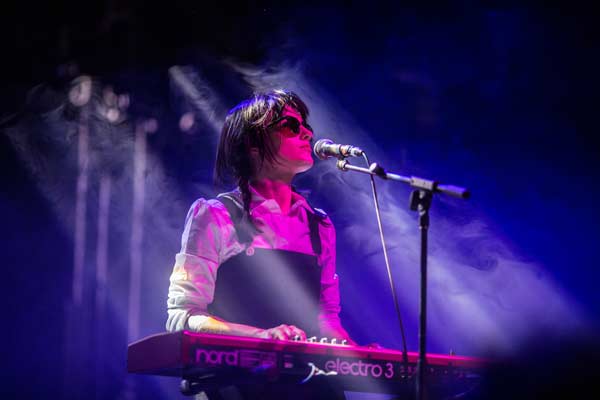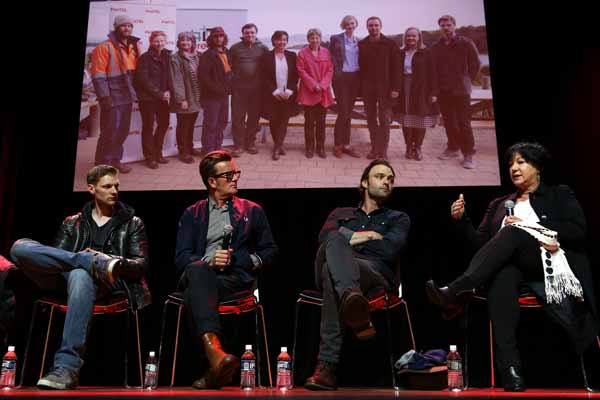The winter festival of the Museum of Old and New Art, Dark Mofo, took place 12-22 June, 2015 and revealed the light in the dark, short days of Hobart's winter.
What was most striking about the festival was not the incredible artworks that demonstrated this paradox, but the community spirit that it brought – revealing all of the binary opposites that come together when art, community and festival spirit conjoin.
Dark Mofo had a packed-to-the-brim programme and it became apparent after the first weekend that it would not be possible to see everything! But no matter what your festival journey became, it was inevitable you would be wowed, see things you’ve never seen before and be inspired by works that had the capacity to make crowds realise how integral art is to our lives.
The major light piece was the Pulse Column by Canadian–Mexican artist Rafael Lozano-Hemmer, which beamed eight spotlights into the sky, visible from all of Hobart. The lights would pulse with the heartbeat of the festival-goer holding a bar with an in-built pulse-o-meter. This created a small, beautiful connection over a huge distance.
It bound each individual that participated; both with the night sky and those watching the light from afar. Our hearts are the most protected part of the human body, and the work encouraged people to reveal them with light to a city bathed in darkness. In Pulse Column, Dark Mofo captured Hobart’s love for connecting outside at a time when people often stay indoors.
Dark Park was a new festival hub, set in an abandoned, freight train precinct (the soon-to-be-developed Macquarie Point) on the docks next to the river. It heralded works such as Fire Organ, created by Dutch artist Bastiaan Maris and producer Duckpond.

Fire Organ - Image © MONA/ Derek Tickner
A massive construction of steel pipes played fire like a musical instrument. This towering spectacle wowed the crowds – particularly the loud firing bangs of what were deemed ‘crack pipes’ – horizontal gas chambers that were released with a spark plug to make a sound akin to fireworks.
The Bass Bath was created by artist Byron J Scullin with producing team Supple Fox and required a health and safety waiver to enter. Once inside, heavy duty low-frequency bass with a spectacular strobing light show flowed through one’s body, vibrating to one’s very heart.

The Bass Bath - Image © MONA/Rémi Chauvin
Anthony McCall, one of the great minimalist artists of our time, was the name behind Solid Light Works; a huge warehouse filled with projections of solid light for children and adults alike to play in.
Finally, the Ogoh-Ogoh were gigantic, paper maché Balinese Hindu creatures created by Indonesian artists and University of Tasmania students, which ate the community’s fears. These fears were privately written by tens of thousands across the duration of the festival, young and old alike.

Ogoh-Ogohs - Image © MONA/ Derek Tickner
The Ogoh-Ogohs were processioned from Dark Park to the Winter Feast (on the opposite side of the Port of Hobart) on the final, Sunday night – the longest night – for ignition that involved more than 10,000 crowd members; one of the most important ceremonies of the festival.
The music programme included something for everyone, with headliners including pop group The Preatures, doom-metal band Pallbearer, electronic performance art group EYE: Circom, Australian rock icon Gareth Liddiard; and it goes without saying, Antony and the Johnsons – a standout act. Tasmanians and punters from all over Australia dressed up for this incredible performance by one of the great tragically beautiful chanteuses of our time.

The Preatures - Image © MONA/ Rosie Hastie
Equally special were the Midnight Concerts in St David’s Cathedral. Classical music filled the incredible church, vibrating the souls who braved the freezing night.
The Dark Mofo Films programme featured a world premiere of The Kettering Incident, a new television series filmed in Tasmania. It was a clear hit in Tasmania, with sessions selling out both the Odeon Theatre and all eight screens at the independent State Cinema in North Hobart (c.1913).

The Kettering Incident - Image © MONA/ Derek Tickner
This highlighted the fact Tasmania, and Hobart in particular, has one of the most supportive arts communities in the nation. Their pride in their actors, landscape and filmmakers were on show in abundance.
And of course there was Blacklist, the aptly named afterparty which had everything Mona festivals have become famous for. Filled with the binary of macro/ micro events that puts this festival on the map, experiences ranged from costumed dames on horses; a smoking bus playing metal that carried less than ten people at a time; gigantic, rotating stage performances with dancers; gigantic ,dance parties under white sheets and a kissing booth where one shared a pash to cheesy music with a stranger – projected at time on the main stage screens.

Blacklist - Image © Derek Tickner
There were many more events happening in this afterparty that featured the biggest surprises of the festival and the loosest of crowds. The most exclusive of these were faux abductions – this journalist did not get taken - but tales were told of people being kidnapped in the night, blindfolded and driven in the back of a van to random locations.
When they were dropped back off at the party they were released with pictures of where they had been taken, and left to drink, dance and talk to the gargantuan party about their experience. This experience beautifully addressed fear; using humour to demonstrate that even in the night anything can be overcome.
The festival went out with a splash; the annual Nude Solstice Swim bringing many brave bodies (752 to be exact) who donned red swimming caps and nothing else on a frosty, winter morning for a swim. They swam out and on their return they closed the festival by putting their clothes back on.
Once again Hobart was returned to normality. For another year there would be no more communally naked bodies on the beach, no more kissing strangers (facilitated by a sign-up sheet stating “I am not a creep”), and no more Night Ship – Anthony McCall’s third piece, which had searched the shores with a single beam of light for ghosts of the festival.
There was still one last light show in the sky. An aurora put on a spectacular display the night after the festival closed, linking Dark Mofo once more with the night and the ethereal magic of art meets life.
– written by Eloise Maree






